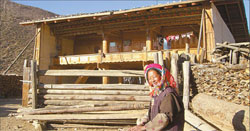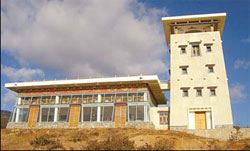Greening Shangri-la
Wood stocks out the front of this Tibetan two-storey house are used for a family's heating and cooking. Heavy wood consumption in the region has aroused concern from environ- |
"It is urgent to protect the forest resources in Shangri-la," Bai Wenfeng, a professor with the Green House Project under Kunming University of Science and Technology of Yunnan, told China Daily.
His concern stems from the centuries-old lifestyle of Tibetans in Diqing Tibet Autonomous Prefecture of Yunnan Province.
Their spacious homes need an average of 200 cubic meters of wood, which is equivalent to clearing one hectare of natural forests.
Everything in the house is made from wood: furniture, floor, stairs, fences and inner walls, and this means at least 10 cubic meters of wood from increasingly scarce fir trees.
To fire their stoves for heating and cooking, each family burns another 14 cubic meters of wood a year.
This large amount of wood consumption has recently aroused much concern from environmentalists.
This botanical museum launched by The Nature Conservancy in Shangri-la County of Diqing showcases its "green building" concepts. Xie Chuanjiao |
"The forest reserves in Shangri-la County alone are equal to the whole of that in Fujian Province, but the forests are being consumed as fuel and as construction wood, especially under the acute pressure of population growth here.
"The ecosystem here is so fragile: the cold temperature and thin earth layers prevent trees from re-growing fast," Bai said.
He Qiang, former head of the Diqing Prefecture Forestation Bureau and now director of The Nature Conservancy (TNC) Shangri-la Field Office, is himself Tibetan and a witness to the rapid deforestation.
"The population in Diqing has doubled in the past 50 years," He said.
"The Tibetans here are building many more houses, and the rich ones tend to build larger and more expensive ones consuming huge quantities of wood," He said.
 TNC, the non-government organization based in the United States, has started two sample projects in Shangri-la County of Diqing to showcase its "green building" concepts, directed especially at the local Tibetans.
TNC, the non-government organization based in the United States, has started two sample projects in Shangri-la County of Diqing to showcase its "green building" concepts, directed especially at the local Tibetans.
One of the project is a botanical museum which has been established for local bio-species research.
According to project manager Tang Letian, the building has been designed in a style consistent with local architecture and in harmony with the natural environment: solar energies have been tapped extensively for heating purposes.
Inside the building, the earth floors help store the heat, reducing the need for high-energy consuming materials such as cement or brick. The use of recycled materials, as well as bamboo for the wall, flooring and doors, helps reduce wood consumption.
In the other project, the Geza Green School, wood use has dropped by 60 percent, and that of steel, sand and stone by 20 percent.
"These buildings provide the required levels of comfort, while also adhering to the principles of reduce, reuse and recycle," Tang said.
"We have also retained local traditional culture, such as color painting and wood carving," he added.
Local experts were invited to take part in the design and construction in order to expose them to advanced engineering techniques and to integrate traditional building techniques into the project.
"We need support from the local government, who should tighten the logging ban, guide locals, promote green housing concepts and give subsidies to residents," Tang said.
But it remains difficult to promote the idea among local Tibetans, according to Tang.
In Zongba village where the Geza School is located, the locals are a well-off lot.
"We don't want to change our living habits. In cold winters we have to warm food for both family and my 20 some yaks and 10 plus yellow cows," said local villager Zanbu.
Qilinongbu, an official of Gongbin Village, said what made it difficult to promote the project was the lack of money. He expected the government would provide favorable policy to encourage local villagers to use new materials and technology.
But there is hope with the provincial government allocating 200,000 yuan ($25,641) to start renovating existing Tibetan houses.
Liu Yongli, a local official, said three villages have been selected, and construction will begin soon.
(China Daily 02/28/2007 page19)
















